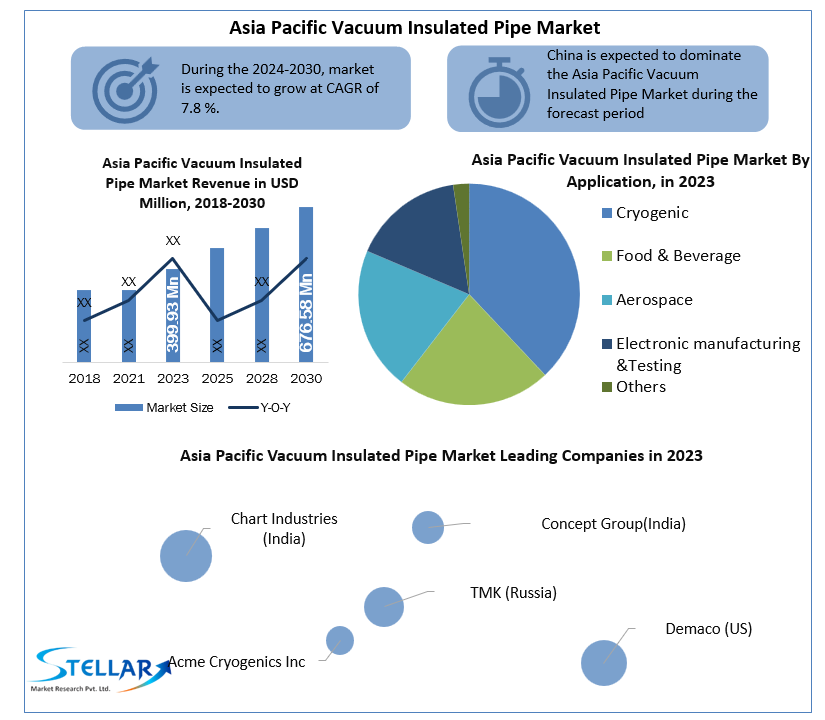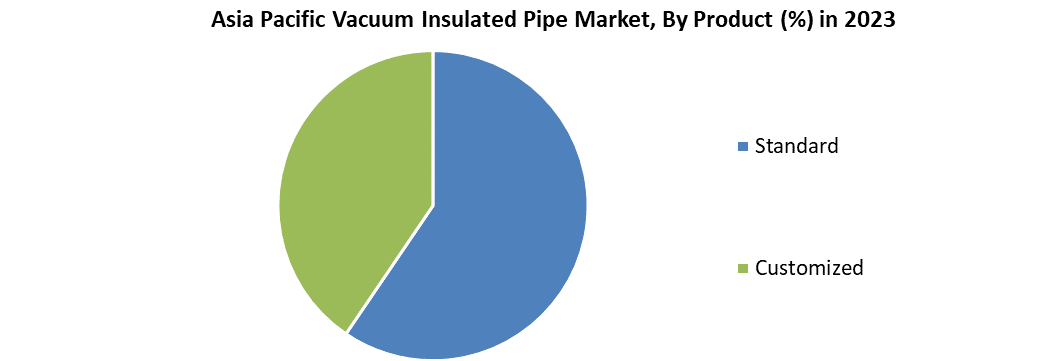Asia Pacific Vacuum Insulated Pipe Market: Industry Analysis and Forecast (2024-2030)
Asia Pacific Vacuum Insulated Pipe Market was valued at USD 399.93 million in 2023 and the market size is estimated to grow at a CAGR of 7.8 % over the forecast period.
Format : PDF | Report ID : SMR_1096
Asia Pacific Vacuum Insulated Pipe Market Definition:
Vacuum insulated pipes are a cost-effective way of transporting high-quality cryogenic liquids such as hydrogen, oxygen, and natural gas in a wide range of industries. They're highly safe, reliable, and affordable. Vacuum insulated pipes also aid in the reduction of liquid cryogen loss caused by heat leaks, as well as improving process safety by removing frosty and leaking conditions. When compared to conventional foam-insulated copper piping, vacuum insulated pipes have a longer lifecycle.
Further, the Asia Pacific Vacuum Insulated Pipe market is segmented by product, application, and geography. On the basis of application, the Asia Pacific Vacuum Insulated Pipe market is segmented under cryogenic, food & beverages, aerospace and electronic manufacturing and testing. Based on the product the market is segmented standard and customized. By geography, the market covers the major countries in Asia Pacific i.e., India, China, Japan, Australia and Rest of Asia Pacific For each segment, the market sizing and forecasts have been done on the basis of value (in USD Million).

To get more Insights: Request Free Sample Report
Asia Pacific Vacuum Insulated Pipe Market COVID 19 Insights:
COVID-19's outbreak has a negative impact on the regional market. However, because to the availability of COVID-19 vaccinations and immunization efforts conducted by the governments of APAC countries, industrial activities gradually started to return in 2021. As a result, demand for vacuum insulated pipes has increased, resulting in market growth over the forecast period.
Asia Pacific Vacuum Insulated Pipe Market Dynamics:
The installation of these pipes will be driven by increased demand for cryogenic liquids such as LNG, nitrogen, oxygen, and helium, as well as increased investments in the healthcare and chemical industries. The manufacturing sector, which includes the chemical, refining, and food and beverage industries, will simply drive natural gas use. Product demand will gain from the paradigm shift toward gas-based generating power plants, as well as increased use of natural gas in the heating and transportation sectors. Furthermore, due to their lower heat loss qualities, market players are focused on the installation of pipes across the petrochemical, frozen food, and electronic manufacturing industries, which will improve the market over the forecast period.
One of the major factors driving the vacuum-insulated piping market is the increase in LNG trading.
During the forecast period, demand for LNG as a cryogenic fuel would grow in tandem with the use of natural gas. Because of its thermal insulation capacity, vacuum-insulated piping is often used for LNG transportation. In a steady-state operating situation, the boil-off gas is drastically reduced due to vacuum insulated piping technologies. It also ensures that pipes cool down faster. Because of these advantages, LNG producers favor vacuum insulated pipes for LNG transportation over alternative options. As a result, as the demand for LNG rises, the need for vacuum insulated piping will rise as well during the forecast period.
One of the reasons hampering the growth of the vacuum-insulated piping market is the uncertainty associated with crude oil prices.
Many products derived from crude oil, such as lubricants and gasoline, are directly impacted by crude oil pricing. The most significant impact of crude oil price fluctuations is on profitability and the cascading effects that result from a lack of it. The cost of manufacturing the product will be the same as the cost of production and transportation of crude oil if simple economic fundamentals in hydrocarbon production operations are considered. As a result, production decreases in tandem with the fall in selling price. Many oil initiatives have been put on hold or canceled as a result of the drop in selling prices. This will have a negative impact on the cryogenic fuels market. As a result of the decrease in production, there will be a reduced demand for cryogenic fuels and, as a result, for vacuum insulated piping. This is hampering the market's growth.
Asia Pacific Vacuum Insulated Pipe Market Segment Analysis:
By Product, Continuous investments in the food and beverage, aerospace, and semiconductor sectors have produced a favorable business environment for specialized vacuum insulated pipes. The products are widely used in the aerospace, semiconductor, and food and beverage markets, presenting significant opportunities for vacuum insulated pipe penetrating. These pipes are custom-made to suit the needs of each individual customer and are used to control the flow of cryogenic liquid at the end-user location. Furthermore, rising oxygen use in the health sector, as well as rising demand for packaged foods, meat, and dairy products, would boost the market growth.

By Application, Due to the obviously increased LNG trade, the cryogenic industry will see significant growth.
Government rules and mandates aimed at environmental protection will subsequently increase natural gas adoption, boosting demand for vacuum insulated pipes. The shift to a gas-based economy, owing to the company's preference for gas power plants, will boost product demand much more. The development of new gas-fired power plants, as well as the removal of coal-fired power plants, has been helped by a combination of supporting clean fuel laws and competitive gas pricing. Furthermore, increasing technological advancements in the exploration of unconventional oil and gas resources to overcome the shortfall have provided a favorable business environment for market players to grow.
Asia Pacific Vacuum Insulated Pipe Market Key Players Insights:
The market is characterized by the existence of a number of well-known firms. These companies control a large portion of the market, have a wide product portfolio, and have a global presence. In addition, the market comprises small to mid-sized competitors that sell a limited variety of items, some of which are self-publishing organizations.
The market's major companies have a significant impact because most of them have extensive global networks through which they can reach their massive client bases. To drive revenue growth and strengthen their positions in the market, key players in the market, particularly in this region, are focusing on strategic initiatives such as acquisitions, new collection launches, and partnerships.
The objective of the report is to present a comprehensive analysis of the Asia Pacific Vacuum Insulated Pipe market to the stakeholders in the industry. The report provides trends that are most dominant in the Asia Pacific Vacuum Insulated Pipe market and how these trends will influence new business investments and market development throughout the forecast period. The report also aids in the comprehension of the Asia Pacific Vacuum Insulated Pipe Market dynamics and competitive structure of the market by analyzing market leaders, market followers, and regional players.
The qualitative and quantitative data provided in the Asia Pacific Vacuum Insulated Pipe market report is to help understand which market segments, regions are expected to grow at higher rates, factors affecting the market, and key opportunity areas, which will drive the industry and market growth through the forecast period. The report also includes the competitive landscape of key players in the industry along with their recent developments in the Asia Pacific Vacuum Insulated Pipe market. The report studies factors such as company size, market share, market growth, revenue, production volume, and profits of the key players in the Asia Pacific Vacuum Insulated Pipe market.
The report provides Porter's Five Force Model, which helps in designing the business strategies in the market. The report helps in identifying how many rivals exist, who they are, and how their product quality is in the Asia Pacific Vacuum Insulated Pipe market. The report also analyses if the Asia Pacific Vacuum Insulated Pipe market is easy for a new player to gain a foothold in the market, do they enter or exit the market regularly, if the market is dominated by a few players, etc.
The report also includes a PESTEL Analysis, which aids in the development of company strategies. Political variables help in figuring out how much a government can influence the Asia Pacific Vacuum Insulated Pipe market. Economic variables aid in the analysis of economic performance drivers that have an impact on the Asia Pacific Vacuum Insulated Pipe market. Understanding the impact of the surrounding environment and the influence of environmental concerns on the Asia Pacific Vacuum Insulated Pipe market is aided by legal factors.
Asia Pacific Vacuum Insulated Pipe Market Scope:
|
Asia Pacific Vacuum Insulated Pipe Market Scope |
|
|
Market Size in 2023 |
USD 399.93 Mn. |
|
Market Size in 2030 |
USD 676.58 Mn. |
|
CAGR (2024-2030) |
7.8% |
|
Historic Data |
2018-2022 |
|
Base Year |
2023 |
|
Forecast Period |
2024-2030 |
|
Segment Scope |
By Application
|
|
By Product
|
|
|
Country Scope |
|
Asia Pacific Vacuum Insulated Pipe Market Key Players:
- Chart Industries (India)
- Concept Group(India)
- TMK (Russia)
- Demaco (US)
Frequently Asked Questions
The market size of the Asia Pacific Vacuum Insulated Pipe Market by 2030 is expected to reach USD 676.58 Million.
The forecast period for the Asia Pacific Vacuum Insulated Pipe Market is 2024-2030.
The market size of the Asia Pacific Vacuum Insulated Pipe Market in 2023 was valued at USD 399.93 Million.
- Scope of the Report
- Research Methodology
- Research Process
- Asia Pacific Vacuum Insulated Pipe Market: Target Audience
- Asia Pacific Vacuum Insulated Pipe Market: Primary Research (As per Client Requirement)
- Asia Pacific Vacuum Insulated Pipe Market: Secondary Research
- Executive Summary
- Competitive Landscape
- Stellar Competition matrix
- Asia Pacific Stellar Competition Matrix
- Key Players Benchmarking: - by Product, Pricing, Investments, Expansion Plans, Physical Presence, and Presence in the Market.
- Mergers and Acquisitions in Industry: - M&A by Region, Value, and Strategic Intent
- Market Dynamics
- Market Drivers
- Market Restraints
- Market Opportunities
- Market Challenges
- PESTLE Analysis
- PORTERS Five Force Analysis
- Value Chain Analysis
- Stellar Competition matrix
- Asia Pacific Vacuum Insulated Pipe Market Segmentation
- Asia Pacific Vacuum Insulated Pipe Market, by Product (2023-2030)
- Standard
- Customized
- Asia Pacific Vacuum Insulated Pipe Market, by Raw Material (2023-2030)
- Cryogenic
- Food & Beverage
- Aerospace
- Electronic manufacturing and testing
- Others
- Asia Pacific Vacuum Insulated Pipe Market, by Country (2023-2030)
- India
- China
- Japan
- Australia
- Rest of Asia Pacific
- Asia Pacific Vacuum Insulated Pipe Market, by Product (2023-2030)
- Company Profiles
- Key Players
- Concept Group (India)
- Company Overview
- Product Portfolio
- Financial Overview
- Business Strategy
- Key Developments
- TMK (Russia)
- Demaco (US)
- Chart Industries (India)
- Concept Group (India)
- Key Players
- Key Findings
- Recommendations
















